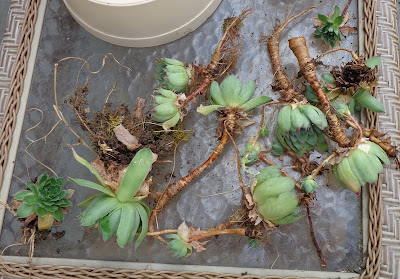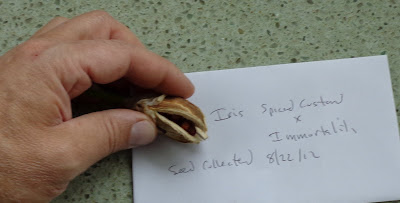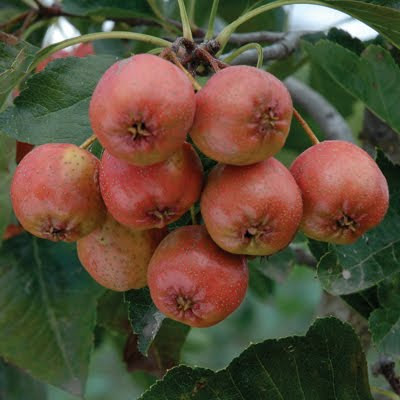These are heritage Irises from
Green Thumbs Galore in Chattanooga Tennessee. The variety pics are from their website - should be OK since I provide a link. I went Bonkers with irises this year. Not clear on where they will all be planted. These went into containers, for now.
New Irises are flashy, with bright, diverse colors and patterns, big flowers, and ruffles. Some are not great in the rain, becoming malformed globs of petals, and stalks that fall over. Fragrance has not been retained in hybridization, except for a few.
Heritage irises have simpler form, fewer more muted colors, and smaller flowers. This is a generalization that is not be 100% true. They are more likely to be Fragrant, I think. I hope the smaller simpler flowers and stems will hold up in the rain.
I consider this my "test garden". I plan to give away the ones I don't like. That may be a few years down the road. It's not so Darwinian with Irises. They don't die off, even with neglect. They may quit blooming, but so far I haven't had one variety die off. Some - just a couple - did not grow at the outset - all dried out rhizomes from big box stores, planted in late fall. One might have grown but was in a bad spot and hasn't bloomed yet in 3 years. I moved it, we'll see if that's the one, when it blooms.

The rhizomes arrived nicely packaged. They appear freshly dug, with no drying of leaf tips. The packaging was slightly moist but no mold or mildew. I get the feeling they were dug up for my order - nice thought. There were fewer roots and more top than some other orders - I don't think that's a problem, just a difference. Transplanting them from the humid summer of TN to the dry summer of WA, and the differences in soil and winter climate, they may have a bit of a shock.

No place set aside for them yet. Irises have limited root systems, so I planted in containers. As long as I keep them watered they should be OK. I can moved them into a sheltered spot this winter, if needed. If I get a location cleared and prepared, I'll move them into the ground. I'm curious about how they will do in containers, anyway. The largest really should go into the ground.

Loreley. Heritage Iris Preservation Society (HIPS) lists Loreley as developed in 1909. It appears to be a much smaller variety. Hybridized by "Goos & Koenemann"

Unknown Variety, "NoID" listed as "purple with silver beard, bitone".

Unknown Variety, "NoID" listed as "Lilac".

Helen Collingwood.
Heritage Iris Preservation Society (HIPS) has better pics. They list Helen as developed in 1949. It's big (40 inches) which is opposite of what I said about old varieties. Also very vigorous. No comment there about fragrence.
 Yesterday I picked through the grass and found these specimens. The ultimate goal is to remove anything recoverable, then either let it go to grass, or clean the area completely and mulch. The tree is gradually dying, so maybe remove the tree and start over. Meanwhile, here are the Sempervivums. This is a testament to their rugged nature - covered with grass, full sun, and no watering for 2 years. These plants came from my parents' yard in Illinois, years ago. My Dad told me he got them from his parents' yard long before that. I have quite a few others, from the same original two starts that I brought here - but nice to recover these too. They are soft, dried, wrinkly, but I think they are alive. The "tap-root" may just be stem.
Yesterday I picked through the grass and found these specimens. The ultimate goal is to remove anything recoverable, then either let it go to grass, or clean the area completely and mulch. The tree is gradually dying, so maybe remove the tree and start over. Meanwhile, here are the Sempervivums. This is a testament to their rugged nature - covered with grass, full sun, and no watering for 2 years. These plants came from my parents' yard in Illinois, years ago. My Dad told me he got them from his parents' yard long before that. I have quite a few others, from the same original two starts that I brought here - but nice to recover these too. They are soft, dried, wrinkly, but I think they are alive. The "tap-root" may just be stem.
 Blurry. It was evening. These were planted in the Battleground place, in a bed that I recently improved with compost and planted. Planting just involved using a trowel to make a slit in the ground, insert the "root" so that the plant is a ground level, then firm the soil. I did water it in to settle the soil and get them started. As always, "We'll see".
I read that Medieval European peasants throw Sempervivum onto their straw roofs to grow and deter lightening strikes. If true, they survived very dry conditions to grow on the roof. So maybe these will recover too.
Blurry. It was evening. These were planted in the Battleground place, in a bed that I recently improved with compost and planted. Planting just involved using a trowel to make a slit in the ground, insert the "root" so that the plant is a ground level, then firm the soil. I did water it in to settle the soil and get them started. As always, "We'll see".
I read that Medieval European peasants throw Sempervivum onto their straw roofs to grow and deter lightening strikes. If true, they survived very dry conditions to grow on the roof. So maybe these will recover too.























